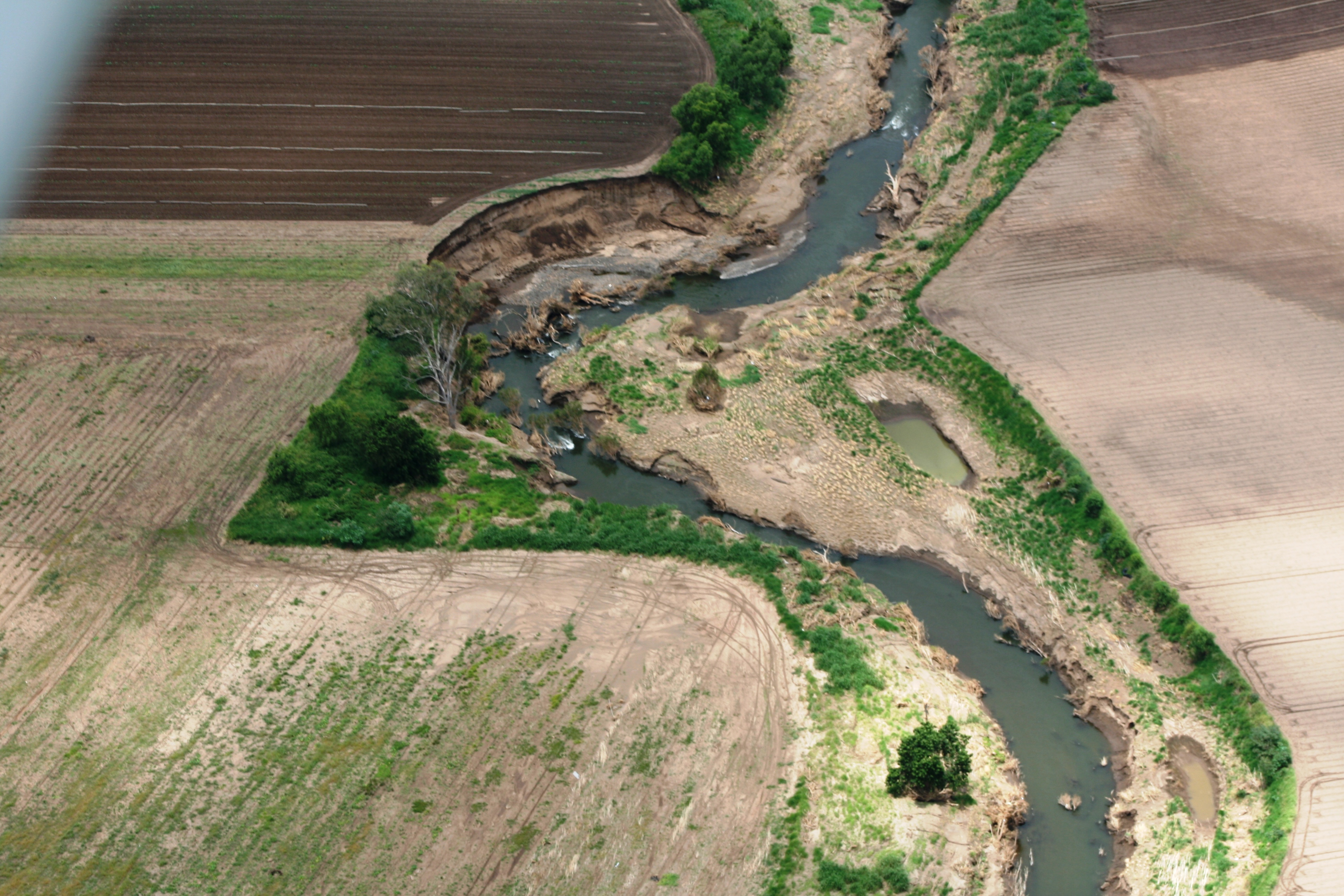The clearer the trigger or initiative, the easier it is to identify who or what will benefit from rehabilitation, and what services are being targeted. Documenting the trigger or initiative that started the rehabilitation process in a rehabilitation plan will ensure that the project remains in scope. Further investigation (for example, how climate change is affecting flood frequency and intensity) may identify that the trigger or initiative is only part of a broader issue. This may require modifications to the project.
What triggers aquatic ecosystem rehabilitation?
Aquatic ecosystem rehabilitation can be triggered or initiated due to something that is predicted to happen (for example, planned urbanisation in a catchment), or in response to recent (e.g. natural disaster) or past (e.g. sand extraction from a river bed) events. Irrespective of the trigger or initiative, application of the Whole-of-System Values-Based framework (Framework) to aquatic system management and rehabilitation will facilitate responses that are more proactive and less reactive.

In cases where the initiative is based around the prediction of an event, there is often more time to develop a deeper understanding of the issues and how to respond to them. Natural disasters can result in the perceived or real need for near instantaneous responses. Reacting rather than responding to such events (e.g. a large flood event), can lead to costly interventions that may not have been needed or that have unintended consequences. A proactive alternative is to pre-plan using the Framework so that relevant information and data is available to inform disaster management responses. A triage approach, where issues are identified, ranked and addressed based on risk and the Framework, can be applied after a disaster event. This information can also be used to develop a longer-term plan that prevents reoccurrence and improves resilience to future events.
Examples of triggers and initiatives can be found in the table below.
Potential triggers and initiatives for aquatic ecosystem rehabilitation
| Potential Triggers and Initiatives |
Comments |
|
Flood events
|
Can result in risk to land and infrastructure from flood water, erosion and deposition.
|
|
Flood mitigation
|
Rehabilitation may be undertaken to reduce the impact of flooding downstream by reconnecting floodplains, increasing channel and floodplain roughness with vegetation or reinstating or reconnecting wetlands.
|
|
Legal obligations
|
Can include the requirement to remove an invasive weed or maintain a protected species. It can also include the need to rehabilitate an area due to illegal actions.
|
|
Loss of native vegetation
|
Can cause a change in the services provided by the site.
|
|
Habitat reinstatement for biodiversity purposes
|
Providing or improving habitat for a species or range of species, may remove threats and reinstate components and processes.
|
|
Better delivery of ecosystem services (e.g. Blue Carbon)
|
Improving the components and processes to optimise the delivery of ecosystem services such as the sequestering and storing of carbon.
|
|
Investment
|
External funding from investment and insurance companies can proactively initiate rehabilitation projects.
|
|
Wildfire events
|
Can result in the loss of catchment vegetation combined with an increase in sediment and organics into aquatic ecosystems and may require intervention to reduce future impacts.
|
|
River re-adjustment after disturbance
|
The channel of a river may change during a flood event then adjust subsequent to the event. The components and processes may need to be managed during this re-adjustment period.
|
|
Changed hydrology (timing, frequency, magnitude, velocity)
|
Water use can result in changes to the water regime of an aquatic ecosystem (e.g. becomes fresh, permanent, less tidal influence, less scouring events) requiring for rehabilitation to maximise services.
|
|
Changed vegetation structure and composition in an aquatic system
|
Vegetation changes can reduce ecosystem services and trigger rehabilitation (removal of weeds, thinning etc.).
|
|
Monitoring findings
|
Monitoring can reveal whether degradation has occurred or is in the process of occurring.
|
|
Land use changes
|
A change in land use, such as urban development or town planning processes, may require improved ecosystem services from an aquatic ecosystem. This may include aesthetics and/or water quality improvement.
|
|
Climate change assessments impact
|
Anthropogenic and natural climate changes can impact processes or components driving ecosystems, prompting rehabilitation activities (such as nature based solutions).
|
|
Water quality improvement requirements
|
Rehabilitation activities include attempts to reduce sediment or nutrient inflow to aquatic ecosystems and valuable downstream assets like Moreton Bay and the Great Barrier Reef.
|
|
Channel widening/narrowing/ deepening/aggradation
|
A change in the rates of these processes can often trigger investigation and rehabilitation actions.
|
|
Loss of land (e.g. a change in channel position such as an avulsion)
|
Action may be needed to reduce actual or predicted land loss.
|
|
Loss or risk to infrastructure (e.g. roads, bridges, buildings)
|
Action may be needed to minimise future risks to infrastructure (note: actions such as relocating infrastructure rather than investing in rehabilitation of the existing site need to be considered).
|
|
Loss of social values
|
Rehabilitation can maintain, improve or enhance aesthetic values.
|
|
Loss of heritage sites (e.g. Traditional owner sites and artifacts)
|
Burial or erosion of heritage sites can mean that actions need to be managed.
|
|
Threat or loss of water supply (agricultural, industrial, or potable)
|
A change in the volume or quality of water impacting water supplies can trigger rehabilitation actions.
|
|
Environmental offsets
|
Development approval may require compensation for impacts on Matters of Environmental Significance (national, state or local) where impacts are unavoidable.
|
Last updated: 18 June 2022
This page should be cited as:
Department of Environment, Science and Innovation, Queensland (2022) Triggers and initiatives for rehabilitation, WetlandInfo website, accessed 8 May 2025. Available at: https://wetlandinfo.des.qld.gov.au/wetlands/management/rehabilitation/rehab-process/triggers.html

 — Department of the Environment, Tourism, Science and Innovation
— Department of the Environment, Tourism, Science and Innovation



